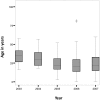Demographic and clinical features of dengue fever in Pakistan from 2003-2007: a retrospective cross-sectional study
- PMID: 20856935
- PMCID: PMC2938342
- DOI: 10.1371/journal.pone.0012505
Demographic and clinical features of dengue fever in Pakistan from 2003-2007: a retrospective cross-sectional study
Abstract
Background: Demographic features of dengue fever have changed tremendously in Pakistan over the past two decades. Small scale studies from all over the country have reported different aspects of individual outbreaks during this time. However, there is scarcity of data looking at the overall trend of dengue virus infection in the country. In this study, we examined annual trends, seasonality, and clinical features of dengue fever in the Pakistani population.
Methods: Demographic information and dengue IgM status of all patients tested for dengue IgM antibody at Aga Khan University Hospital from January 2003 to December 2007 were analyzed to look for trends of IgM-positive cases in Pakistan. In addition, clinical and biochemical parameters were abstracted retrospectively from medical records of all patients hospitalized with IgM-proven dengue fever between January 2006 and December 2007. These patients were categorized into dengue fever and dengue hemorrhagic fever according to the WHO severity grading scale.
Results: Out of a total of 15,040 patients (63.2% male and 36.8% female), 3952 (26.3%) tested positive for dengue IgM antibody. 209 IgM proven dengue patients were hospitalized during the study period. During 2003, IgM positive cases were seen only during the months of July-December. In contrast, such cases were detected throughout the year from the 2004-2007. The median age of IgM positive patients decreased every year from 32.0 years in 2003 to 24.0 years in 2007 (p<0.001). Among hospitalized patients, nausea was the most common presenting feature found in 124/209 (59.3%) patients. Children presented with a higher median body temperature than adults (p = 0.010). In addition, neutropenia was seen more commonly in children while raised serum ALT levels were seen more commonly in adults (both p = 0.006). While a low total white cell count was more common in patients with dengue fever as compared to Dengue Hemorrhagic Fever (p = 0.020), neutropenia (p = 0.019), monocytosis (p = 0.001) and raised serum ALT level (p = 0.005) were observed more commonly in the latter group.
Conclusions: Dengue virus is now endemic in Pakistan, circulating throughout the year with a peak incidence in the post monsoon period. Median age of dengue patients has decreased and younger patients may be more susceptible. Total and differential leukocyte counts may help identify patients at risk of hemorrhage.
Conflict of interest statement
Figures




Similar articles
-
Seroepidemiology of dengue fever in Khyber Pakhtunkhawa, Pakistan.Int J Infect Dis. 2013 Jul;17(7):e518-23. doi: 10.1016/j.ijid.2013.01.007. Epub 2013 Mar 21. Int J Infect Dis. 2013. PMID: 23523057
-
"Preliminary Seroepidemiological survey of dengue infections in Pakistan, 2009-2014".Infect Dis Poverty. 2017 Mar 9;6(1):48. doi: 10.1186/s40249-017-0258-6. Infect Dis Poverty. 2017. PMID: 28274279 Free PMC article.
-
Dengue fever is an emerging public health concern in the city of Multan, Pakistan: its seroprevalence and associated risk factors.Microbiol Immunol. 2018 Nov;62(11):729-731. doi: 10.1111/1348-0421.12649. Epub 2018 Oct 29. Microbiol Immunol. 2018. PMID: 30216495
-
Clinical manifestations of dengue hemorrhagic fever in Puerto Rico, 1990-1991. Puerto Rico Association of Epidemiologists.Rev Panam Salud Publica. 1997 May;1(5):381-8. doi: 10.1590/s1020-49891997000500007. Rev Panam Salud Publica. 1997. PMID: 9180059 Review.
-
Epidemiological trends and risk factors associated with dengue disease in Pakistan (1980-2014): a systematic literature search and analysis.BMC Public Health. 2018 Jun 15;18(1):745. doi: 10.1186/s12889-018-5676-2. BMC Public Health. 2018. PMID: 29907109 Free PMC article.
Cited by
-
Incidence of Dengue fever, serotypes, clinical features, and laboratory markers: a case study of 2019 outbreak at district Shangla, KP, Pakistan.Afr Health Sci. 2022 Mar;22(1):521-531. doi: 10.4314/ahs.v22i1.61. Afr Health Sci. 2022. PMID: 36032477 Free PMC article.
-
Demographic and clinico-epidemiological features of dengue fever in Faisalabad, Pakistan.PLoS One. 2014 Mar 3;9(3):e89868. doi: 10.1371/journal.pone.0089868. eCollection 2014. PLoS One. 2014. PMID: 24595236 Free PMC article.
-
Diversity of infectious aetiologies of acute undifferentiated febrile illnesses in south and Southeast Asia: a systematic review.BMC Infect Dis. 2019 Jul 4;19(1):577. doi: 10.1186/s12879-019-4185-y. BMC Infect Dis. 2019. PMID: 31272417 Free PMC article.
-
Evaluation of thrombocytopenia in dengue infection along with seasonal variation in rural melmaruvathur.J Clin Diagn Res. 2014 Jan;8(1):39-42. doi: 10.7860/JCDR/2014/6739.3914. Epub 2013 Jan 12. J Clin Diagn Res. 2014. PMID: 24596719 Free PMC article.
-
Evaluation of clinical and laboratory characteristics of dengue viral infection and risk factors of dengue hemorrhagic fever: a multi-center retrospective analysis.BMC Infect Dis. 2024 May 17;24(1):500. doi: 10.1186/s12879-024-09384-z. BMC Infect Dis. 2024. PMID: 38760732 Free PMC article.
References
-
- Guzman MG, Kouri G. Dengue and dengue hemorrhagic fever in the Americas: lessons and challenges. J Clin Virol. 2003;27:1–13. - PubMed
-
- Thomas SJ, Strickman D, Vaughn DW. Dengue epidemiology: virus epidemiology, ecology, and emergence. Adv Virus Res. 2003;61:235–289. - PubMed
-
- Petersen LR, Marfin AA. Shifting epidemiology of Flaviviridae. J Travel Med. 2005;12(Suppl 1):S3–11. - PubMed
Publication types
MeSH terms
Substances
LinkOut - more resources
Full Text Sources
Medical
Miscellaneous

